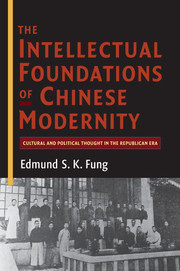 The Intellectual Foundations of Chinese Modernity
The Intellectual Foundations of Chinese Modernity Published online by Cambridge University Press: 03 May 2010
The question of modernity in post-imperial China dates back to the New Culture/May Fourth Movement (1915–23), which is often symbolically interpreted as the Chinese Enlightenment. Just as the European Enlightenment was a diverse and complex movement that developed in different ways in France, England, Scotland and elsewhere with thinkers as diverse as Jean-Jacques Rousseau, Voltaire (François-Marie Arouet), John Locke and David Hume, so New Culture/May Fourth was a multilayered movement that makes an excellent study in contrast. Its strongest feature, as Hao Chang has pointed out, was the binary and dialectical nature (liangqixing) of its thought – rationalism and romanticism, scepticism and ‘new religion’, individualism and collectivist consciousness, nationalism and cosmopolitanism. There were a variety of ideologies – liberalism, democracy, anarchism, socialism, utopianism and humanism, among others – representing competing ideas that interplayed and reacted with one another. As Rana Mitter has written, ‘the May Fourth period marked…a sense of real and impending crisis; a combination of a plurality of competing ideas aimed at “saving the nation”, and an audience ready to receive, welcome, contest, and adapt these ideas’. Two of those ideas were cultural radicalism and cultural conservatism, one representing the modernity of Enlightenment and the other representing counter-Enlightenment.
At the outset, the discourse on modernity concerned the future of Chinese culture in the post-imperial era. To be modern, China needed to Westernize. A number of questions were raised by Republican intellectuals: Where was China going as it met the world without the monarchy? What did Westernization entail?
To save this book to your Kindle, first ensure no-reply@cambridge.org is added to your Approved Personal Document E-mail List under your Personal Document Settings on the Manage Your Content and Devices page of your Amazon account. Then enter the ‘name’ part of your Kindle email address below. Find out more about saving to your Kindle.
Note you can select to save to either the @free.kindle.com or @kindle.com variations. ‘@free.kindle.com’ emails are free but can only be saved to your device when it is connected to wi-fi. ‘@kindle.com’ emails can be delivered even when you are not connected to wi-fi, but note that service fees apply.
Find out more about the Kindle Personal Document Service.
To save content items to your account, please confirm that you agree to abide by our usage policies. If this is the first time you use this feature, you will be asked to authorise Cambridge Core to connect with your account. Find out more about saving content to Dropbox.
To save content items to your account, please confirm that you agree to abide by our usage policies. If this is the first time you use this feature, you will be asked to authorise Cambridge Core to connect with your account. Find out more about saving content to Google Drive.